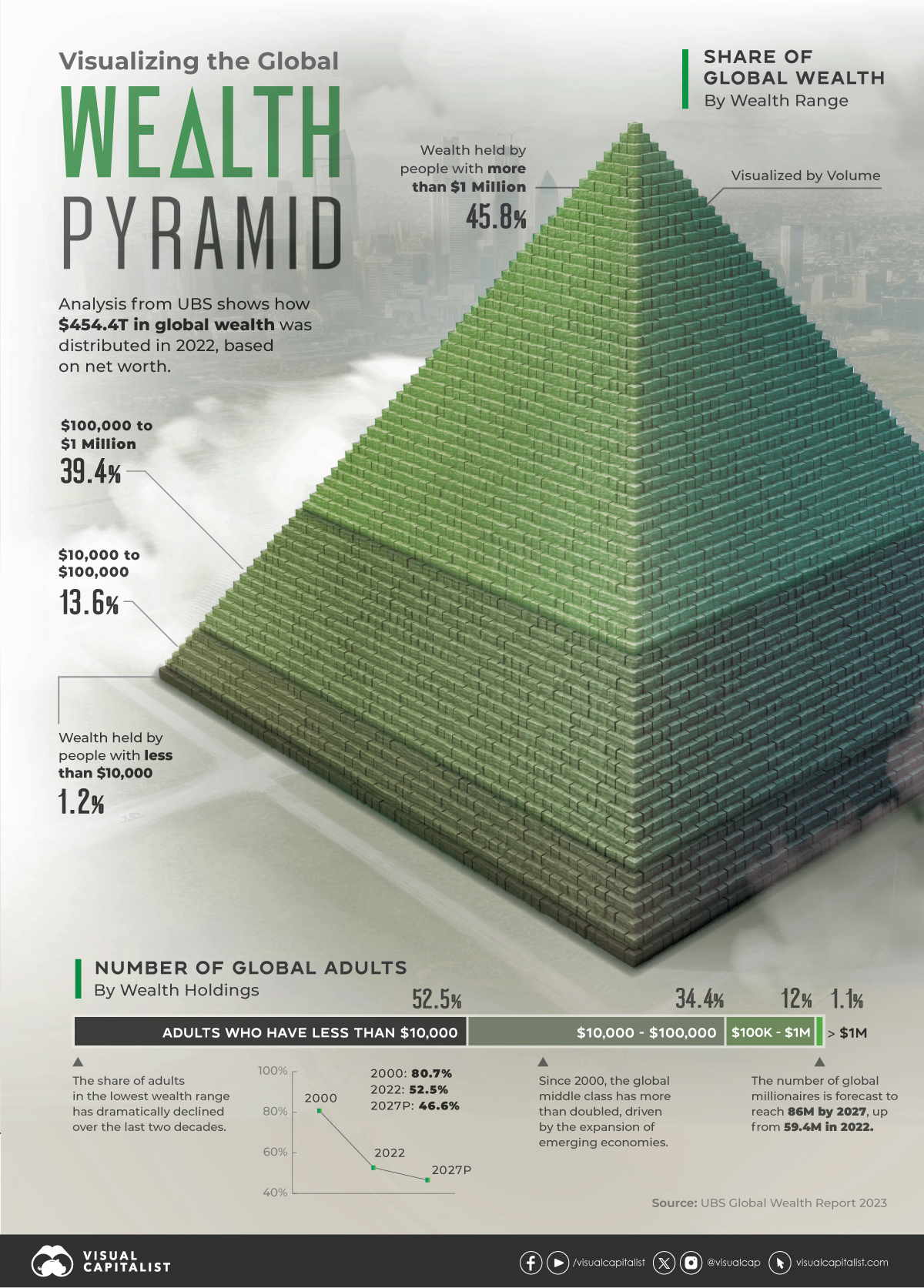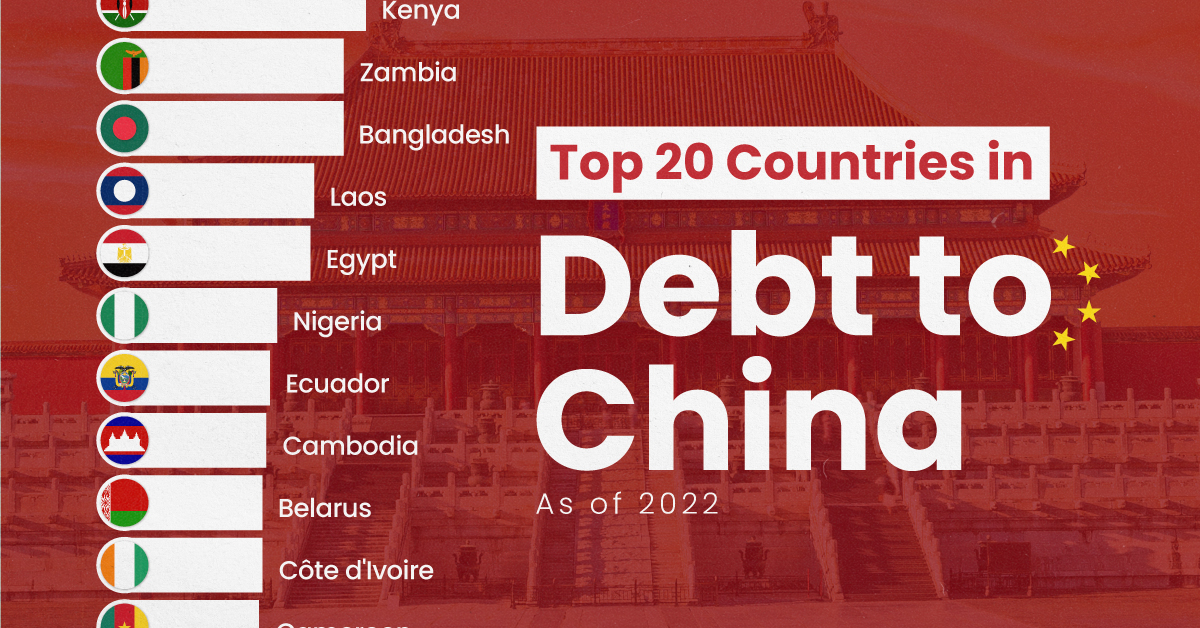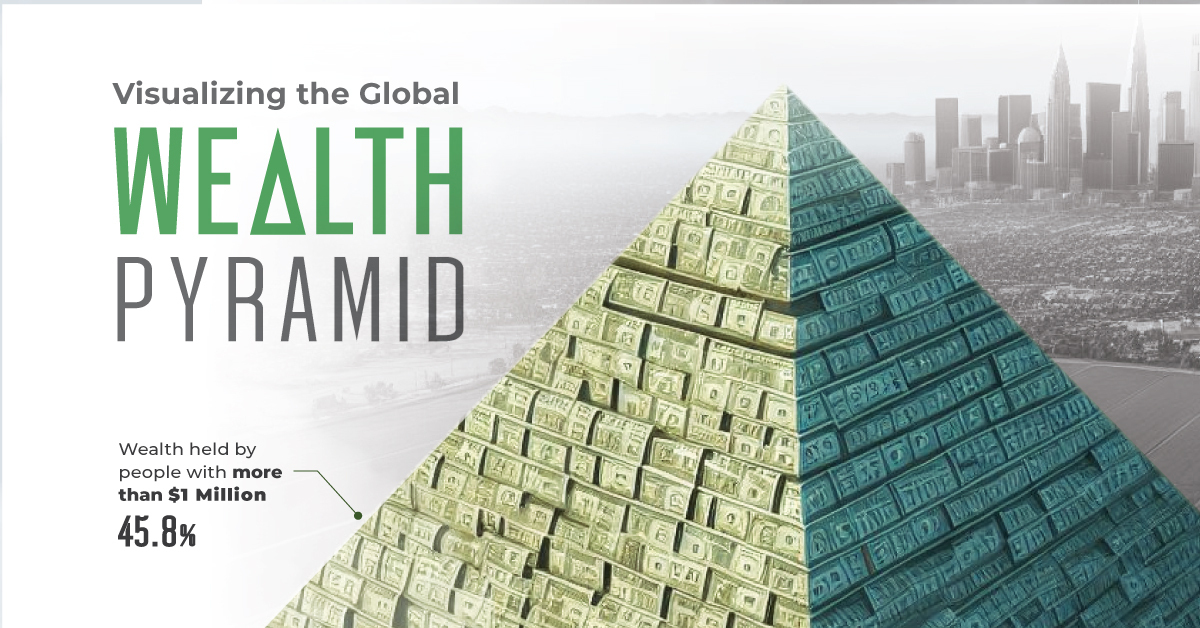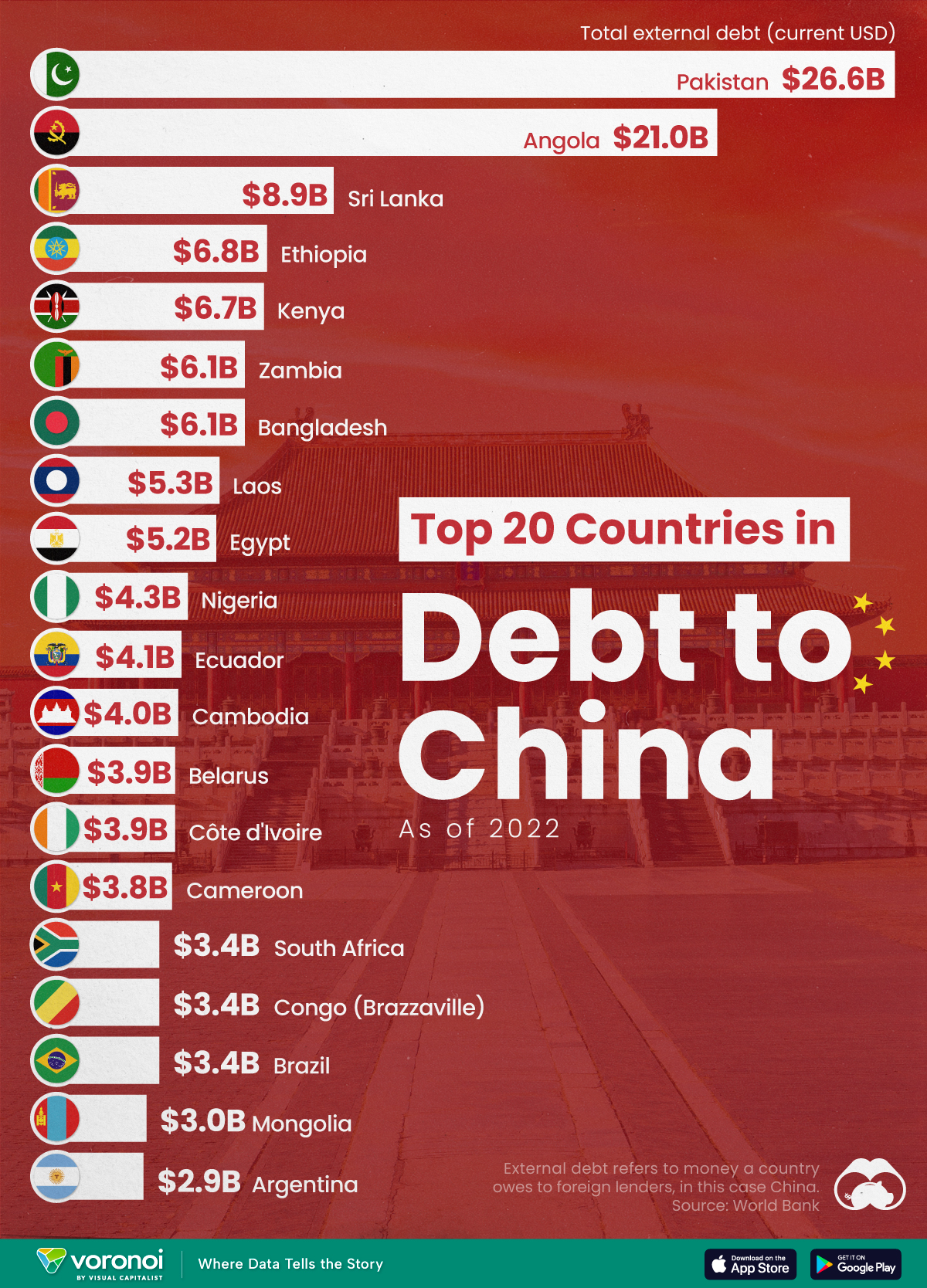Money
Visualizing the Pyramid of Global Wealth Distribution

Visualizing the Pyramid of Global Wealth Distribution
Who controls global wealth?
In 2022, the world’s millionaires held nearly half of net household wealth. Decades of low interest rates led equities and real estate values to soar, and these assets are disproportionately held among the world’s wealthiest.
While a steep rise in interest rates decreased these fortunes in 2022, the share of wealth controlled by the global millionaire population remains substantial.
The above graphic shows the distribution of global household wealth, based on the annual 2023 UBS Global Wealth Report.
The Distribution of Global Wealth
Worldwide net private wealth stood at $454.4 trillion in 2022.
Here’s how it was distributed across various levels of net worth, which takes a person’s financial and real assets such as housing, and subtracts their debt:
| Net Worth | Number of Adults | Share of Adults | Total Wealth | Share of Global Wealth |
|---|---|---|---|---|
| More than $1 million | 59.4M | 1.1% | $208.3T | 45.8% |
| $100,000 to $1 million | 642.0M | 12.0% | $178.9T | 39.4% |
| $10,000 to $100,000 | 1.8B | 34.4% | $61.9T | 13.6% |
| Less than $10,000 | 2.8B | 52.5% | $5.3T | 1.2% |
The highest wealth rung controls $208.3 trillion in wealth, or 45.8% of the global total. Just 1.1% of the world adult population fall in this bracket.
Those with $100,000 to $1 million have the next greatest share, at 39.4% of net household wealth.
We can see that wealth ownership begins to decline dramatically in the next bracket. People with $10,000 to $100,000 control just 13.6% of global wealth. However, the number of people in the global middle class have more than doubled over the last two decades, driven by the rapid expansion of China.
Interestingly, the lowest segment of wealth has shrunk considerably since 2000. Between 2000 and 2022, it fell from 80.7% to 52.5% of the global population, and is projected to keep decreasing. Despite this, the total share of wealth controlled by this rung is just 1.2% of the global total.
Future Outlook
By 2027, global wealth is estimated to reach $629 trillion. Here’s the forecast for how wealth distribution is set to evolve:
| Net Worth | Percent of Global Adults 2000 | Percent of Global Adults 2022 | Percent of Global Adults 2027P |
|---|---|---|---|
| More than $1 million | 0.4% | 1.1% | 1.5% |
| $100,000 to $1 million | 5.5% | 12.0% | 14.8% |
| $10,000 to $100,000 | 13.4% | 34.4% | 37.0% |
| Less than $10,000 | 80.7% | 52.5% | 46.6% |
Over this time period, the global millionaire population is set to reach 86 million. Below, we show how this is projected to change in select markets:
| Country / Region | Number of Millionaires 2022 | Number of Millionaires 2027P | Change 2022-2027P |
|---|---|---|---|
| 🇺🇸 U.S. | 22.7M | 26.4M | 16% |
| 🇨🇳 China | 6.2M | 13.2M | 112% |
| 🇫🇷 France | 2.8M | 4.0M | 43% |
| 🇯🇵 Japan | 2.8M | 3.9M | 40% |
| 🇩🇪 Germany | 2.6M | 3.4M | 30% |
| 🇬🇧 UK | 2.6M | 4.8M | 86% |
| 🇨🇦 Canada | 2.0M | 3.3M | 63% |
| 🇦🇺 Australia | 1.8M | 2.8M | 53% |
| 🇮🇹 Italy | 1.3M | 1.7M | 25% |
| 🇰🇷 South Korea | 1.3M | 2.1M | 64% |
| 🇳🇱 Netherlands | 1.2M | 1.4M | 17% |
| 🇪🇸 Spain | 1.1M | 1.4M | 25% |
| 🇨🇭 Switzerland | 1.1M | 1.5M | 39% |
| 🇮🇳 India | 849,000 | 1.4M | 69% |
| 🇹🇼 Taiwan | 765,000 | 1.3M | 70% |
| 🇭🇰 Hong Kong SAR | 630,000 | 1.1M | 73% |
| 🇧🇪 Belgium | 536,000 | 746,000 | 39% |
| 🇸🇪 Sweden | 467,000 | 670,000 | 44% |
| 🇧🇷 Brazil | 413,000 | 788,000 | 91% |
| 🇷🇺 Russia | 408,000 | 569,000 | 40% |
As the above table shows, double-digit growth in the millionaire population is projected for many markets, with China, Brazil, and the UK forecast to see the fastest growth by 2027.
Overall, total global wealth is forecast to increase 6.7% annually on average by 2027 factoring in current global inflation forecasts and GDP projections.
Economy
Ranked: The Top 20 Countries in Debt to China
The 20 nations featured in this graphic each owe billions in debt to China, posing concerns for their economic future.

Ranked: The Top 20 Countries in Debt to China
This was originally posted on our Voronoi app. Download the app for free on iOS or Android and discover incredible data-driven charts from a variety of trusted sources.
In this graphic, we ranked the top 20 countries by their amount of debt to China. These figures are as of 2022, and come from the World Bank (accessed via Yahoo Finance).
The data used to make this graphic can be found in the table below.
| Country | Total external debt to China ($B) |
|---|---|
| 🇵🇰 Pakistan | $26.6 |
| 🇦🇴 Angola | $21.0 |
| 🇱🇰 Sri Lanka | $8.9 |
| 🇪🇹 Ethiopia | $6.8 |
| 🇰🇪 Kenya | $6.7 |
| 🇧🇩 Bangladesh | $6.1 |
| 🇿🇲 Zambia | $6.1 |
| 🇱🇦 Laos | $5.3 |
| 🇪🇬 Egypt | $5.2 |
| 🇳🇬 Nigeria | $4.3 |
| 🇪🇨 Ecuador | $4.1 |
| 🇰🇭 Cambodia | $4.0 |
| 🇨🇮 Côte d'Ivoire | $3.9 |
| 🇧🇾 Belarus | $3.9 |
| 🇨🇲 Cameroon | $3.8 |
| 🇧🇷 Brazil | $3.4 |
| 🇨🇬 Republic of the Congo | $3.4 |
| 🇿🇦 South Africa | $3.4 |
| 🇲🇳 Mongolia | $3.0 |
| 🇦🇷 Argentina | $2.9 |
This dataset highlights Pakistan and Angola as having the largest debts to China by a wide margin. Both countries have taken billions in loans from China for various infrastructure and energy projects.
Critically, both countries have also struggled to manage their debt burdens. In February 2024, China extended the maturity of a $2 billion loan to Pakistan.
Soon after in March 2024, Angola negotiated a lower monthly debt payment with its biggest Chinese creditor, China Development Bank (CDB).
Could China be in Trouble?
China has provided developing countries with over $1 trillion in committed funding through its Belt and Road Initiative (BRI), a massive economic development project aimed at enhancing trade between China and countries across Asia, Africa, and Europe.
Many believe that this lending spree could be an issue in the near future.
According to a 2023 report by AidData, 80% of these loans involve countries in financial distress, raising concerns about whether participating nations will ever be able to repay their debts.
While China claims the BRI is a driver of global development, critics in the West have long warned that the BRI employs debt-trap diplomacy, a tactic where one country uses loans to gain influence over another.
Editor’s note: The debt shown in this visualization focuses only on direct external debt, and does not include publicly-traded, liquid, debt securities like bonds. Furthermore, it’s worth noting the World Bank data excludes some countries with data accuracy or reporting issues, such as Venezuela.
Learn More About Debt from Visual Capitalist
If you enjoyed this post, check out our breakdown of $97 trillion in global government debt.
-

 Technology7 days ago
Technology7 days agoAll of the Grants Given by the U.S. CHIPS Act
-

 Misc2 weeks ago
Misc2 weeks agoHow Hard Is It to Get Into an Ivy League School?
-

 Debt2 weeks ago
Debt2 weeks agoHow Debt-to-GDP Ratios Have Changed Since 2000
-

 Sports2 weeks ago
Sports2 weeks agoThe Highest Earning Athletes in Seven Professional Sports
-

 Science2 weeks ago
Science2 weeks agoVisualizing the Average Lifespans of Mammals
-

 Brands1 week ago
Brands1 week agoHow Tech Logos Have Evolved Over Time
-

 Energy1 week ago
Energy1 week agoRanked: The Top 10 EV Battery Manufacturers in 2023
-

 Demographics1 week ago
Demographics1 week agoCountries With the Largest Happiness Gains Since 2010















